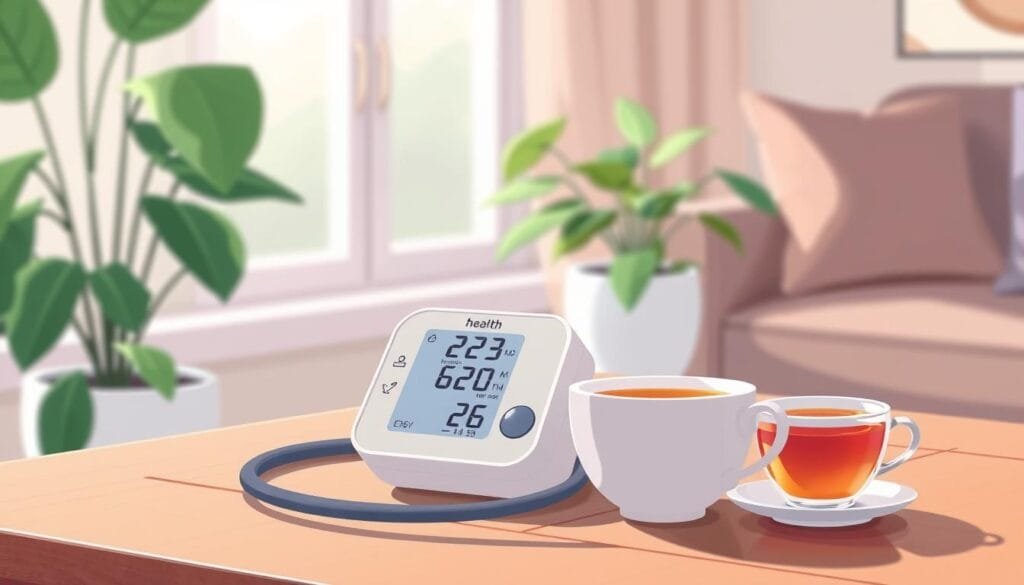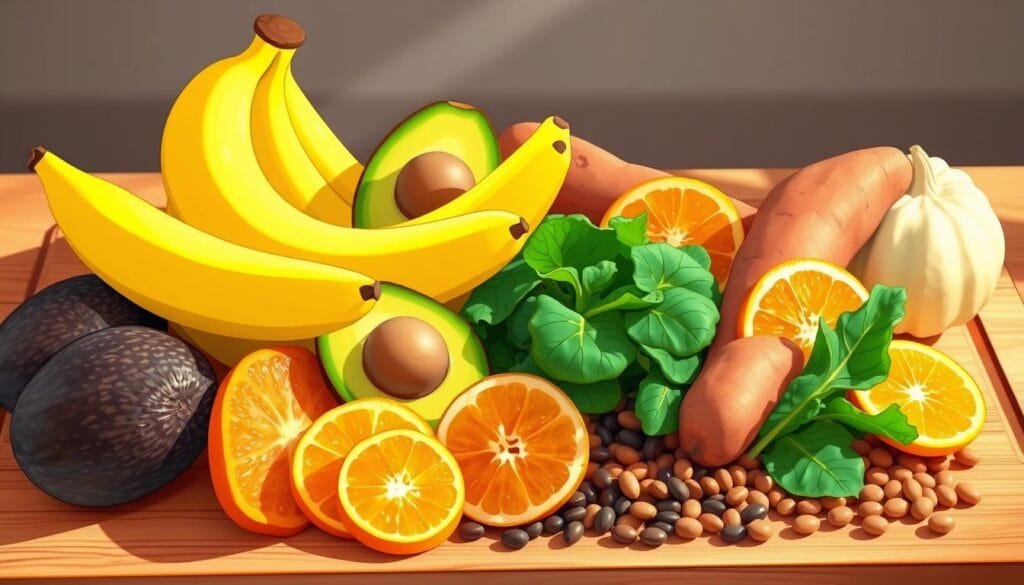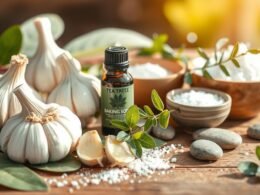Imagine a peaceful morning with your coffee, but then a sharp pain hits your chest. Your heart is racing, and you feel tension. This is what millions of Americans face with hypertension, a silent killer. But, there’s hope without just medication. Welcome to natural remedies for high blood pressure.
Hypertension, or high blood pressure, affects 47% of adults in the U.S. It’s a big risk for heart disease and stroke. While drugs help, lifestyle changes can also control blood pressure naturally. This guide will show you how to lower your blood pressure and improve your heart health.
Key Takeaways
- Controlling hypertension naturally is an effective way to manage high blood pressure without relying solely on medication.
- Lifestyle changes such as weight management, regular exercise, and a healthy diet can significantly lower blood pressure.
- Reducing sodium intake, limiting alcohol consumption, and getting enough sleep are also crucial for controlling hypertension.
- Stress management techniques like meditation and deep breathing can help lower blood pressure.
- Monitoring your blood pressure at home can help you track the effectiveness of your natural remedies.
Lose Extra Weight and Watch Your Waistline
Keeping a healthy weight and managing your waistline are key to controlling high blood pressure. Research shows that losing a little weight can greatly lower your blood pressure. It also cuts down the risk of heart disease.
The American Heart Association (AHA) says losing 10 pounds can help lower blood pressure. The Dietary Approaches to Stop Hypertension (DASH) diet is also effective. It’s full of fruits, vegetables, and whole grains, and can lower blood pressure by up to 11 mm Hg.
Carrying extra weight around your midsection is bad for your blood pressure. The AHA suggests that men should keep their waist under 40 inches. Women should aim for less than 35 inches. Keeping your waist healthy is vital for managing waist circumference to lower blood pressure.
| Metric | Healthy Range | Unhealthy Range |
|---|---|---|
| Waist Circumference (Men) | Less than 40 inches | 40 inches or more |
| Waist Circumference (Women) | Less than 35 inches | 35 inches or more |
By weight loss for hypertension and keeping a healthy waistline, you can control your high blood pressure. This also reduces your risk of heart disease. Remember, even small changes can greatly improve your health and well-being.
Exercise Regularly
Adding regular aerobic exercise to your routine is a top way to manage high blood pressure. The American College of Cardiology and the American Heart Association say it can lower blood pressure by 5 to 8 mm Hg. This drop in blood pressure is crucial for your heart health.
It’s important to pick aerobic activities you like and can do often. Here are some good choices:
- Walking
- Jogging
- Cycling
- Swimming
- Dancing
Try to get at least 150 minutes of moderate aerobic activity or 75 minutes of vigorous aerobic activity per week. You can mix different exercises like brisk walking, hiking, and fitness classes. Adding muscle-strengthening activities two days a week also helps.
It might take 1 to 3 months of regular exercise to see blood pressure changes. Stay patient and keep at it. Enjoying your activities makes it easier to stick with a routine and get the blood pressure-lowering benefits in the long run.
“Regular exercise can lead to a decrease in both systolic and diastolic blood pressure, with drops ranging from 4 to 12 mm Hg diastolic and 3 to 6 mm Hg systolic.”
Before starting any exercise, talk to your healthcare provider. This is especially true if you have health issues or a family history of heart problems. They can create a safe and fitting exercise plan for you.
Eat a Healthy, Balanced Diet
Eating a nutritious diet can help control high blood pressure. Diets full of whole grains, fruits, vegetables, and low-fat dairy can lower blood pressure by up to 11 mm Hg. The DASH (Dietary Approaches to Stop Hypertension) diet and the Mediterranean diet are two effective plans.
The DASH diet limits salt to 2,300 milligrams (mg) a day. A lower sodium version limits it to 1,500 mg a day. It suggests eating 6 to 8 servings of grains, 4 to 5 servings of vegetables, and 4 to 5 servings of fruits daily. Dairy products should be 2 to 3 servings a day.
Lean meats, poultry, and fish should not exceed six 1-ounce servings a day. Nuts, seeds, or dry beans and peas should be in 4 to 5 servings a week. Fats and oils should be 2 to 3 servings a day, and sweets and added sugars should not exceed 5 servings a week.
The Mediterranean diet also focuses on heart health. It includes fruits, vegetables, whole grains, legumes, nuts, seeds, and olive oil. It limits red meat, sodium, added sugars, and sugary drinks, which can raise blood pressure. By choosing a DASH or Mediterranean diet, you can manage your DASH diet for hypertension, Mediterranean diet to manage blood pressure, and healthy eating for high blood pressure.
“A heart-healthy diet is crucial for managing blood pressure and reducing the risk of heart attack, stroke, and other health threats.”
Reduce Salt and Sodium Intake
Lowering your sodium intake is key to managing high blood pressure naturally. The Mayo Clinic says eating less than 1,500 mg of sodium daily can lower blood pressure by 5 to 6 mm Hg. This means reading food labels, picking low-sodium products, and using less table salt.
Cooking at home with fresh ingredients and using herbs and spices can also help. This way, you can eat less sodium.
The American Heart Association recommends no more than 2,300 mg of sodium daily for those with high blood pressure. The ideal is 1,500 mg. Cutting 1,000 mg from your diet can greatly improve your blood pressure and heart health.
Research shows the DASH diet can lower blood pressure by 8 to 14 points. This diet focuses on low-sodium foods.
To cut down on sodium, watch the sodium in processed foods like soups, sauces, and canned goods. These can make up to 70% of an adult’s daily sodium in the U.S. Choose low-sodium versions or fresh foods instead. Seasoning with herbs, spices, and other sodium-free options can also help reduce salt without losing flavor.
| Sodium Intake Recommendations | Daily Limit |
|---|---|
| Minimum Requirement for Health | 500 mg |
| Recommended Limit for Hypertension | 2,300 mg |
| Ideal Limit for Hypertension | 1,500 mg |
| Snacks, Sauces, Dressings, and Processed Meats | 200 mg per serving |
| Ready-to-Eat Meals | 600 mg per serving |
By watching your sodium intake and making a few diet changes, you can lower your blood pressure. This is a big step towards managing your low sodium diet for hypertension and reducing salt intake to manage blood pressure.
Limit Alcohol Consumption
Too much alcohol can harm your blood pressure and heart health. The Mayo Clinic suggests drinking less than one drink a day for women or two for men. This can lower blood pressure by about 4 mm Hg. But, drinking too much can raise blood pressure and heart disease risk.
Alcohol affects blood pressure and heart health worldwide. A study with 767 participants found interesting effects. Low-dose alcohol lowered blood pressure and increased heart rate. Medium-dose alcohol had similar effects but to a lesser extent. High-dose alcohol also lowered blood pressure but raised it later.
This study showed alcohol’s impact on blood pressure and heart rate. It mainly focused on healthy males. Few women were included.
Lowering alcohol intake helps control high blood pressure. The Canadian Hypertension Society advises monitoring and limiting alcohol. This keeps blood pressure healthy and reduces heart disease risk.
“Alcohol consumption is linked to cardiovascular disease mortality in hypertensive men.”
– Malinski MK, Sesso HD, Lopez‐Jimenez F, et al. 2004
Controlling Hypertension Naturally
Managing high blood pressure can be done naturally. Focus on exercise, weight management, and a healthy diet. These changes can help control your blood pressure without medication.
Exercise Regularly
Exercise is key to managing hypertension naturally. Activities like walking, jogging, and swimming can lower blood pressure by 5 to 8 mmHg. Adding these to your routine improves heart health.
Maintain a Healthy Weight
Extra weight can raise blood pressure. Losing 5% of your body weight can lower it. Keeping a healthy waist size is also important.
Follow a Heart-Healthy Diet
Your diet affects blood pressure. Eating whole grains, fruits, and vegetables helps. The DASH and Mediterranean diets are good choices. Limiting sodium to 1,500 mg a day also helps.
| Lifestyle Change | Potential Blood Pressure Reduction |
|---|---|
| Losing 5% of Body Weight | Significant Reduction |
| Reducing Sodium Intake to 1,500 mg/day | 5-6 mmHg |
| Engaging in 150 Minutes of Moderate Exercise per Week | 5-8 mmHg |
| Limiting Alcohol Consumption | 2-4 mmHg |
| Practicing Meditation and Deep Breathing | Potential Reduction |
By changing your lifestyle, you can manage hypertension naturally. This reduces heart disease and stroke risks. Consistency and a holistic approach are crucial for healthy blood pressure.
Quit Smoking
If you’re dealing with high blood pressure, quitting smoking is crucial. Smoking harms your blood vessels and increases blood pressure. Stopping smoking can greatly improve your heart health and manage hypertension naturally.
Research shows that quitting smoking to lower blood pressure offers quick benefits. Just 20 minutes after your last cigarette, your blood pressure and heart rate decrease. The longer you stay smoke-free, the better your heart health gets. Quitting smoking also lowers the risk of heart disease, stroke, and other serious health problems.
Stopping smoking might seem hard, but it’s worth it. Quitting not only helps with blood pressure but also reduces the risk of many health issues. Talk to your doctor for help and advice on quitting smoking and managing hypertension. Your heart will be grateful!
Get Enough Sleep
Getting quality sleep is key to keeping blood pressure healthy. Experts say adults should sleep 7 to 9 hours nightly. Not enough sleep can mess with the body’s natural rhythms and lead to high blood pressure.
Creating a cozy sleep space and sticking to a bedtime routine can help. Avoiding caffeine and screens before bed also improves sleep and blood pressure control.
Research shows sleeping less than six hours is harmful. It can cause blood pressure to rise sharply. This is true for both kids and adults.
Not getting enough sleep can also raise the risk of heart disease. This includes obesity and diabetes.
But, sleeping too much can also be bad. It can lead to high blood sugar and weight gain. Sleep apnea, which interrupts breathing, can increase heart disease risk.
Poor sleep can make high blood pressure worse. It’s crucial to aim for 7 to 9 hours of sleep each night. This helps control blood pressure naturally.
“Lack of sleep can disrupt the body’s natural processes and contribute to the development of hypertension.”
Manage Stress
Chronic stress can raise blood pressure. The body’s fight-or-flight response can increase heart rate and narrow blood vessels. Activities like deep breathing, meditation, or yoga can help relax the body and lower blood pressure.
Finding healthy ways to manage stress is crucial for controlling hypertension naturally.
Stress Management for Hypertension
Stress can quickly increase blood pressure. But when stress goes away, blood pressure returns to normal. Short-term spikes in blood pressure from stress can harm the heart and blood vessels over time.
Managing stress may not lower blood pressure for everyone. But it can improve overall health.
Relaxation Techniques to Lower Blood Pressure
- Adjusting schedules to reduce demands and prioritize self-care
- Practicing deep breathing exercises to activate the parasympathetic nervous system
- Engaging in regular exercise, such as yoga or meditation, to manage stress levels
- Getting enough quality sleep each night to allow the body to rest and recover
- Changing perspectives on challenges and adopting a more positive mindset
By adding these stress-reducing activities to your daily routine, you can manage your hypertension and boost your heart health.
“Managing stress is not just about lowering blood pressure, but about improving overall well-being and quality of life.”
Monitor Your Blood Pressure at Home
Checking your blood pressure at home is a great way to manage high blood pressure naturally. Home monitors are easy to find and help you see if your lifestyle changes are working. Talk to your doctor about how often to check your blood pressure and what numbers are good for you.
Start by checking your blood pressure twice a day, with two or three readings each time. Blood pressure can change throughout the day. So, taking multiple readings gives a clearer picture. Things like stress, smoking, and exercise can raise your blood pressure, so check at the same time every day.
Once a year, take your monitor to the doctor to check if it matches theirs. This makes sure your home readings are accurate for tracking blood pressure changes with lifestyle modifications.
“Lowering systolic blood pressure to a maximum of 120 mmHg has been shown to reduce risks of heart attack, stroke, heart failure, and kidney failure.”
Managing blood pressure is mostly about lifestyle and a bit about medication. So, regularly monitoring your blood pressure at home is key. By watching your readings and adjusting your diet and exercise, you can improve your heart health and aim for better blood pressure.
Control Cholesterol and Blood Sugar
Keeping cholesterol and blood sugar levels healthy is key to lowering heart disease risk. The same lifestyle changes that help lower blood pressure also improve cholesterol and blood sugar. By focusing on your heart health, you can manage hypertension better and reduce heart-related risks.
Adopt a Heart-Healthy Diet
Following the DASH diet or a Mediterranean-style diet can lower blood pressure and cholesterol. These diets focus on whole grains, fruits, vegetables, low-fat dairy, and lean proteins. They also limit sodium, added sugars, and unhealthy fats.
- Aim for 6-8 servings of whole grains per day to help lower cholesterol.
- Consume 4-5 servings of vegetables and 4-5 servings of fruit daily to control blood pressure.
- Choose 3 servings of low- or no-fat dairy products each day to maintain healthy blood pressure.
- Opt for lean meats, poultry, and fish, limiting servings to 6 or fewer per day.
- Include nuts, legumes, and seeds up to 5 times per week for additional heart-healthy benefits.
- Limit fats and oils to 2-3 servings per day to prevent high cholesterol and heart disease.
- Consume sweets in moderation, with a recommendation of 5 or fewer servings per week.
Manage Blood Sugar Levels
Healthy blood sugar levels are also important for controlling hypertension and heart disease risk. Eating a diet rich in fiber and nutrients can help manage blood sugar and cholesterol.
- Increase your intake of vegetables, fruits, whole grains, and lean proteins to support blood sugar control.
- Limit refined carbohydrates and added sugars, which can spike blood sugar levels.
- Incorporate healthy fats, such as those found in avocados, nuts, seeds, and olive oil, to improve blood sugar and cholesterol management.
- Engage in regular physical activity to help regulate blood sugar and maintain a healthy weight.
By making lifestyle changes that support healthy cholesterol and blood sugar levels, you can effectively manage hypertension and reduce your risk of heart disease.
| Cholesterol Goals | Blood Sugar Goals |
|---|---|
|
|
“Maintaining healthy cholesterol and blood sugar levels is crucial for reducing the risk of heart disease and managing hypertension.”
Increase Potassium Intake
Eating more foods rich in potassium can help manage high blood pressure naturally. Potassium helps balance out the effects of sodium, which can raise blood pressure.
The American Heart Association suggests eating 3,500 to 5,000 milligrams of potassium daily. This amount can lower blood pressure by 4 to 5 mm Hg.
Great sources of potassium include leafy greens, bananas, and dairy products. For example, a medium banana has 451 milligrams of potassium. A half-cup of cooked sweet potatoes has 286 milligrams.
The DASH diet is also good for managing blood pressure. It includes foods like fruits, vegetables, whole grains, and low-fat dairy. Adding these foods to your meals can help keep your blood pressure healthy.
Remember, always talk to your doctor before changing your diet or taking potassium supplements. High potassium levels can cause nausea, vomiting, and muscle weakness. So, it’s important to watch your levels closely.
“Increased potassium consumption was associated with lower blood pressure, with the greatest benefits observed in women consuming the highest levels of salt.”
Consider Dark Chocolate and Cocoa
Looking for a natural way to control high blood pressure? Dark chocolate and cocoa powder might help. Research shows their flavonoids can positively affect blood pressure.
A 2017 study found that cocoa can lower blood pressure in healthy adults. Flavonoids in dark chocolate and cocoa widen blood vessels. This improves blood flow and lowers pressure. Choose non-alkalized cocoa powder for more flavonoids and less sugar.
The Evidence on Dark Chocolate and Cocoa
A study linked dark chocolate intake to lower blood pressure and clot risk. A meta-analysis of 35 trials showed cocoa can slightly lower blood pressure. This effect is seen with 30 to 1,218 mg of flavanols daily.
Dark chocolate with 50 to 70 percent cocoa can also help lower blood pressure. It increases insulin sensitivity, which reduces diabetes risk.
| Nutrient | Amount per 100g of Dark Chocolate (50-70% Cocoa) |
|---|---|
| Fiber | 11g |
| Iron | 7.6mg |
| Magnesium | 228mg |
| Phosphorus | 308mg |
| Zinc | 3.3mg |
| Catechins | 46-61mg |
Want to naturally manage high blood pressure? Try dark chocolate or cocoa powder. Pick options with high cocoa content and little sugar for the best health benefits.
Try Meditation and Deep Breathing
Meditation and deep breathing can help manage hypertension naturally. These methods activate the parasympathetic nervous system. This system helps the body relax and digest.
By reducing stress, they can lower blood pressure. Studies show that even a few minutes a day can make a big difference. This can lead to lower systolic and diastolic blood pressure.
Meditation for Hypertension
Mindfulness-based stress reduction (MBSR) can help with attention and blood pressure. It’s especially beneficial for women with cancer. Breathing awareness meditation also helps with blood pressure in African American teens.
Deep Breathing Exercises to Manage Blood Pressure
Deep breathing exercises, like Inspiratory Muscle Strength Training (IMST), can lower blood pressure. IMST boosts endothelial function by 45% in six weeks. It also improves exercise tolerance by 12% in older adults.
Adding meditation and deep breathing to your daily routine can help with hypertension. They reduce stress and activate the parasympathetic nervous system. This can lead to lower blood pressure and better heart health.
“Stress reduction interventions, such as breathing awareness meditation, influenced ambulatory blood pressure and sodium excretion in African American adolescents.”
Conclusion
Controlling high blood pressure naturally is a strong way to boost your heart health. By losing weight, exercising, and eating right, you can lower your blood pressure. Cutting down on salt and alcohol and managing stress also helps.
Using relaxation techniques is another key part. Keeping an eye on your progress and making changes helps you stay on track. This way, you can keep your blood pressure healthy and avoid heart disease.
By taking control of your health naturally, you can enjoy lasting benefits. This approach improves your overall well-being.
Changing your lifestyle to manage high blood pressure is empowering. It lets you take charge of your heart health. By making these changes, you can lower your blood pressure and reduce heart disease risk.
Improving your lifestyle for better blood pressure can greatly enhance your life quality. It’s a positive step towards a healthier you.
The journey to naturally control high blood pressure takes commitment. But the benefits are huge. Start using the strategies from this article for a healthier life. Your heart will be grateful.
FAQ
What are some effective natural ways to control hypertension?
Effective ways to control hypertension include losing weight and exercising regularly. Eating a healthy diet and reducing salt intake are also key. Limiting alcohol and quitting smoking are important. Getting enough sleep and managing stress through meditation can also help.
How can losing weight help lower blood pressure?
Losing just 2.2 pounds (1 kilogram) can lower blood pressure by about 1 mm Hg. Keeping your waist size under 40 inches (102 cm) for men and 35 inches (89 cm) for women is crucial.
What are the benefits of regular aerobic exercise for hypertension?
Regular aerobic exercise, like walking or swimming, can lower blood pressure by 5 to 8 mm Hg. It strengthens the heart and improves blood flow, helping to lower blood pressure.
How can a healthy, balanced diet help manage hypertension?
Eating whole grains, fruits, and vegetables can lower blood pressure by up to 11 mm Hg. The DASH and Mediterranean diets are effective for managing high blood pressure.
How much should I reduce my sodium intake to lower blood pressure?
Limiting sodium to 1,500 mg daily can lower blood pressure by 5 to 6 mm Hg. Read labels, choose low-sodium products, and use less table salt.
How does alcohol consumption affect blood pressure?
Too much alcohol can raise blood pressure and increase heart disease risk. Drinking less than one drink a day for women or two for men can lower blood pressure by about 4 mm Hg.
How do lifestyle changes help control hypertension naturally?
Changes like regular exercise, healthy weight, and a low-sodium diet can manage high blood pressure naturally. These changes help without needing medication.
How can quitting smoking improve blood pressure and heart health?
Smoking is a big risk for high blood pressure and heart disease. Quitting can immediately lower blood pressure and reduce heart risks.
How much sleep do I need to maintain healthy blood pressure levels?
The National Heart, Lung, and Blood Institute suggests 7 to 9 hours of sleep nightly. Lack of sleep can lead to high blood pressure.
How can managing stress help lower blood pressure?
Chronic stress can raise blood pressure. Activities like deep breathing or yoga can relax the body and lower blood pressure.
How can monitoring blood pressure at home help manage hypertension?
Checking blood pressure at home tracks your progress. Talk to your doctor about how often and what readings are best for you.
How do cholesterol and blood sugar levels affect hypertension?
Healthy cholesterol and blood sugar levels are key for heart health and managing hypertension. A healthy diet and exercise can improve these levels.
How can increasing potassium intake help control hypertension?
Eating foods high in potassium, like bananas, can help lower blood pressure. Aim for 3,500 to 5,000 mg of potassium daily to see benefits.
How can dark chocolate and cocoa help manage hypertension?
Dark chocolate and cocoa contain flavonoids that may help blood pressure. These compounds can widen blood vessels and improve blood flow.
What are the benefits of meditation and deep breathing for hypertension?
Meditation and deep breathing can relax the body and lower blood pressure. They activate the parasympathetic nervous system, reducing stress and blood pressure.
Source Links
- 10 medicine-free ways to control high blood pressure – https://www.mayoclinic.org/diseases-conditions/high-blood-pressure/in-depth/high-blood-pressure/art-20046974
- Natural Ways to Lower Blood Pressure – https://www.hopkinsmedicine.org/health/conditions-and-diseases/high-blood-pressure-hypertension/natural-ways-to-lower-blood-pressure
- 7 Home Remedies for Managing High Blood Pressure – https://www.healthline.com/health/high-blood-pressure-home-remedies
- Natural Ways To Lower Your Blood Pressure – https://www.apwuhp.com/how-to-lower-your-blood-pressure-without-medication/
- Why exercise is medicine for high blood pressure – https://www.mayoclinic.org/diseases-conditions/high-blood-pressure/in-depth/high-blood-pressure/art-20045206
- Getting Active to Control High Blood Pressure – https://www.heart.org/en/health-topics/high-blood-pressure/changes-you-can-make-to-manage-high-blood-pressure/getting-active-to-control-high-blood-pressure
- How to make the DASH diet work for you – https://www.mayoclinic.org/healthy-lifestyle/nutrition-and-healthy-eating/in-depth/dash-diet/art-20048456
- Managing Blood Pressure with a Heart-Healthy Diet – https://www.heart.org/en/health-topics/high-blood-pressure/changes-you-can-make-to-manage-high-blood-pressure/managing-blood-pressure-with-a-heart-healthy-diet
- Low Sodium Diet and Lifestyle Changes for High Blood Pressure – https://www.hopkinsmedicine.org/health/wellness-and-prevention/low-sodium-diet-and-lifestyle-changes-for-high-blood-pressure
- Shaking the Salt Habit to Lower High Blood Pressure – https://www.heart.org/en/health-topics/high-blood-pressure/changes-you-can-make-to-manage-high-blood-pressure/shaking-the-salt-habit-to-lower-high-blood-pressure
- Effect of alcohol on blood pressure – https://www.ncbi.nlm.nih.gov/pmc/articles/PMC8130994/
- Excessive Alcohol Consumption and Hypertension: Clinical Implications of Current Research – https://www.ncbi.nlm.nih.gov/pmc/articles/PMC8109365/
- 15 natural ways to lower your blood pressure – https://www.medicalnewstoday.com/articles/318716
- Changes You Can Make to Manage High Blood Pressure – https://www.heart.org/en/health-topics/high-blood-pressure/changes-you-can-make-to-manage-high-blood-pressure
- 5 Ways to Lower Your Blood Pressure Naturally – https://www.houstonmethodist.org/blog/articles/2023/jan/how-to-lower-blood-pressure-without-medication/
- Can a lack of sleep cause high blood pressure? – https://www.mayoclinic.org/diseases-conditions/high-blood-pressure/expert-answers/sleep-deprivation/faq-20057959
- 18 Ways to Lower Your Blood Pressure – https://www.healthline.com/health/high-blood-pressure-hypertension/lower-it-fast
- How To Lower and Control High Blood Pressure Levels – https://www.webmd.com/hypertension-high-blood-pressure/how-to-lower-blood-pressure
- Stress and high blood pressure: What’s the connection? – https://www.mayoclinic.org/diseases-conditions/high-blood-pressure/in-depth/stress-and-high-blood-pressure/art-20044190
- Checking Your Blood Pressure at Home – https://www.webmd.com/hypertension-high-blood-pressure/hypertension-home-monitoring
- 6 Natural Ways To Lower Your Blood Pressure – https://health.clevelandclinic.org/6-natural-ways-to-lower-blood-pressure
- DASH Diet for Heart Health — Lowering Blood Pressure and Cholesterol – https://www.webmd.com/cholesterol-management/ss/slideshow-dash-diet
- High Cholesterol and High Blood Pressure – https://www.webmd.com/cholesterol-management/high-cholesterol-and-high-blood-pressure
- What Can I Eat to Keep My Blood Sugar and Cholesterol Low? – https://www.healthline.com/nutrition/blood-sugar-and-cholesterol-friendly-foods
- How Potassium Can Help Control High Blood Pressure – https://www.heart.org/en/health-topics/high-blood-pressure/changes-you-can-make-to-manage-high-blood-pressure/how-potassium-can-help-control-high-blood-pressure
- Can potassium-rich foods lower your blood pressure and keep your heart healthy? – https://www.bhf.org.uk/informationsupport/heart-matters-magazine/news/behind-the-headlines/potassium-and-heart-health
- Hypertension: Eating dark chocolate may help reduce risk – https://www.medicalnewstoday.com/articles/dark-chocolate-hypertension-blood-pressure-lowering-effect
- Dark Chocolate Helps Lower Blood Pressure, Heart Disease Risk – AARP Bulletin – https://www.aarp.org/health/medical-research/info-03-2011/dark-chocolate-can-help-lower-your-blood-pressure.html
- Effect of cocoa on blood pressure – https://www.ncbi.nlm.nih.gov/pmc/articles/PMC6478304/
- Current Perspectives on the Use of Meditation to Reduce Blood Pressure – https://www.ncbi.nlm.nih.gov/pmc/articles/PMC3303565/
- Daily ‘breath training’ can work as well as medicine to reduce high blood pressure – https://www.npr.org/sections/health-shots/2022/09/20/1123500781/daily-breath-training-can-work-as-well-as-medicine-to-reduce-high-blood-pressure
- Breathing exercise for hypertensive patients: A scoping review – https://www.ncbi.nlm.nih.gov/pmc/articles/PMC9905130/
- The Natural Treatment of Hypertension – https://www.ncbi.nlm.nih.gov/pmc/articles/PMC8109646/
- How to Prevent High Blood Pressure: MedlinePlus – https://medlineplus.gov/howtopreventhighbloodpressure.html
- DASH Diet To Stop Hypertension – StatPearls – https://www.ncbi.nlm.nih.gov/books/NBK482514/













